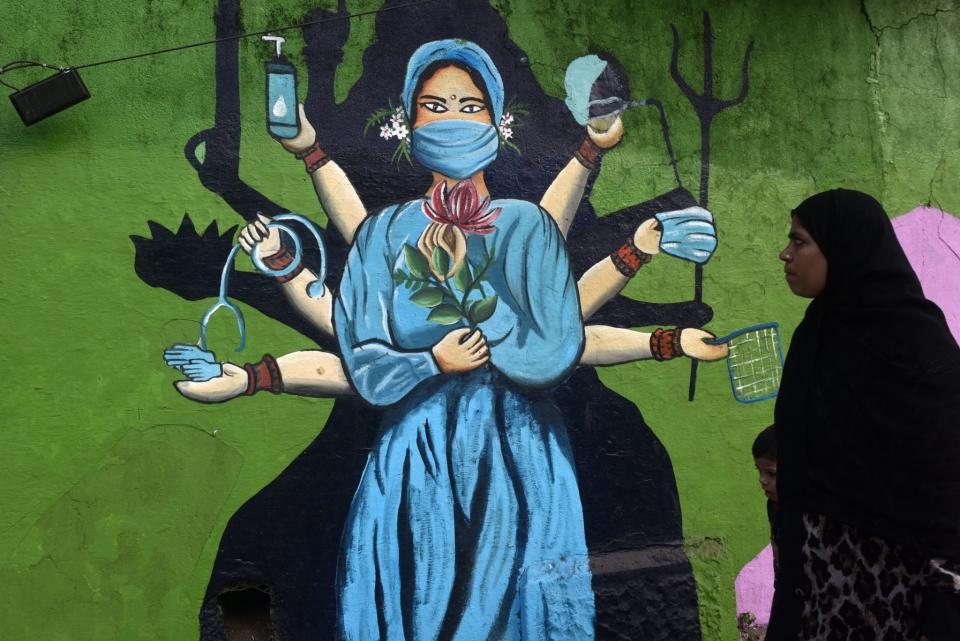Highly mutated COVID variant ‘Pirola’ JN.1 is spawning. Its descendants are climbing the charts, as the global death toll mounts

Nearly 10,000 COVID deaths occurred globally in December, the World Health Organization said this week—this as highly mutated variant “Pirola” JN.1 offspring spawn and begin their upward ascents in the U.S. and elsewhere.
The global wave occurs after holiday gatherings, as expected, and comes as JN.1 dominates worldwide, the organization’s director general, Tedros Adhanom Ghebreyesus, said at a Wednesday news conference in Geneva.
Reported COVID hospitalizations increased by 42%, Ghebreyesus said, and ICU admissions by 62% in December, when compared to November.
The numbers are certainly underestimates, he added. That's because only a quarter of the world’s countries are still providing COVID data to the WHO—less than 50 of 193 nations, most located in Europe and America.
“Although 10,000 deaths a month is far less than the peak of the pandemic, this level of preventable death is not acceptable,” he said.
‘Pirola’ JN.1 spawn take off
The global trends mirror those in the U.S., where COVID deaths were up 12.5% week-over-week and hospitalizations were up more than 20% as of Dec. 30, according to the U.S. Centers for Disease Control and Prevention.
In the U.S., too, JN.1 dominates, comprising an estimated 62% of cases as of Jan. 6, according to the latest CDC projections.
The highly mutated variant's spawn are already climbing the charts, according to Raj Rajnarayanan—assistant dean of research and associate professor at the New York Institute of Technology campus in Jonesboro, Ark., and a top COVID variant tracker.
JN.1.4—a “child," so to speak, of JN.1—was the No. 3 most commonly reported variant in the U.S. on Thursday, comprising 11.5% of sequences, Rajnarayanan told Fortune, citing data from GISAID, an international research organization that tracks changes in COVID and the flu virus.
It’s responsible for 11% of sequences globally, he added.
Other Pirola spawn topping the U.S. variant chart included JN.1.1, which comprised 6% of sequences, and JN.1.2, which comprised a little over 1% of sequences, as of Thursday.
#COVID19 #VariantDashboard - #USA #SARSCoV2 #Lineages #30DAYTRENDS
JN.1 (27.7%)👁️
HV.1 (14.9%)⬇️
JN.1.4 (11.5%)⬆️👀
JN.1.1 (5.9%)
JD.1.1 (2.8%)
HK.3 (2.4%)
JG.3 (1.9%)
FL.1.5.1 (1.4%)
BA.2.86.1 (1.3%)
JN.1.2 (1.3%)Tracker: https://t.co/C4MNBUxBZA | 01/11/24
1/n pic.twitter.com/9EoshLL2Jf— Raj Rajnarayanan (@RajlabN) January 11, 2024
“Pirola” JN.1 may be the beginning of a new chapter in the pandemic, some experts say, with potentially all major variants evolving from it for a time. Forthcoming variants—33 sublineages have been spotted already, Rajnarayanan said—are likely to pick up additional mutations that could very well help the virus.
JN.1.6.1 includes mutation "spike R346T," which JN.1 doesn't contain—one that could make it even more immune evasive, he added. Some previous variants like BA.2.75.2, BA.4.6, BQ.1.1, and XBB.1 also contained the mutation.
"JN.1 and its derivatives will continue to dominate the global landscape for the foreseeable future," Jay Weiland—a variant forecaster with a reputation for high accuracy and one of few left in the business—told Fortune.
Another COVID variant, "Kraken" XBB.1.5, saw its U.S. peak last winter—the nation's second highest, at the time. Its derivatives will continue to circulate at low levels, Weiland says.
"It is yet to be seen if the XBB lineages will go fully extinct, or if they will be able to mutate to hang on to some share of the global variant pool," he added.
It's also possible that another BA.2.86 spawn, like JN.2, eventually rises to prominence, Weiland and Rajnarayanan contend—similar to how the original Omicron, BA.1, peaked briefly eventual dominance of the BA.2 "stealth Omicron" line.
Based on wastewater data, Weiland predicts that the American wave has reached its peak and will soon crest. This winter's wave was the second highest the country has seen so far, with an estimated 1 in 21 Americans infected, as of Tuesday. It knocks last winter's XBB.1.5 peak to spot No. 3 on the list of the country's largest COVID waves.
Wastewater update 1/9/24:
As +/- predicted by the 5 1/2 week old model (next post), new Biobot data suggests we are at peak levels. Should decline from here.
🔸1,570,000 new infections/day
🔸1 in every 210 became infected today
🔸1 in every 21 people currently infected pic.twitter.com/OoU6vXsZxW— JWeiland (@JPWeiland) January 9, 2024
But now is not the time to breathe a sigh of relief, Ryan Gregory—a biology professor at the University of Guelph in Ontario, Canada, and a lead variant tracker—told Fortune.
The concern was never just JN.1 itself—just as the concern was never BA.2.86, its parent variant, itself either, he contends.
"It's not about any one variant," Gregory said. "It's about evolving lineages."
He and fellow variant trackers have dubbed BA.2.86, JN.1, and all viral offspring the "Pirola" clan. It's a family that will keep spawning more relatives, he said, "as long as it has a rich supply of new hosts—that is, until we get serious about mitigation."
This story was originally featured on Fortune.com
